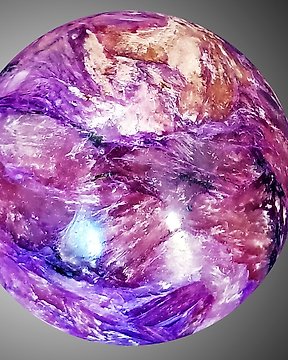
Charoite Spheres, (Lake Baikal)- 220 g - (2)
N.º 82008945

N.º 82008945

Charoite Cabochons - Height: 12 mm - Width: 12 x7 mm 31 g - (16)
Beautiful Rare Charoite bracelet Jewellery Lot Gift Box Chariote - 65×55×55 mm - 39 g
Beautiful Rare Charoite bangle bracelet Jewellery Lot Gift Box Chariote - 67×55×55 mm – 31 g
Yakutia, Russia
Beautiful Rare Charoite bangle bracelet
Jewellery Lot Gift Box
Russia
Bracelet 31 g inner diameter 55 mm, outside diameter 67 mm
The bracelet consists of 16 links each link size ~12 x 11 x 6 mm
Since the color of the bracelet depends on the calibration of the monitor, the photo of the bracelet is taken against the background of the hand.
Since there are deposits of charoite only in Russia, it means that only Russia has access to charoite. This mineral is starting to be very trendy. And therefore the price is constantly going up.
The first charoite was discovered in 1948 in Yakutia at the watershed of the Chara and Tokko rivers by the Russian geologist V.G. Ditmar. The very same charoite deposit was discovered by Yu. A. Alekseev and Yu. G. Rogov only in 1973 during the construction of the Yakut BAM. To search for analogs of the new mineral, Yu. G. Rogov was sent to France specifically to compare the lilac specimen with specimens of stones from the Louvre collection, which at that time was considered a complete collection of rocks from all over the world. It turned out that none of the geologists had ever seen a stone like a charoite. Employees of the Louvre offered Rogov to sell it at a good price, but of course he refused. In 1977, the name Charoite, given to him in honor of the rivers on which he was discovered, was officially registered.
Charoite stone belongs to the pyroxene group. This is a fairly soft ornamental stone. The beautiful lilac color of charoite is due to the presence of manganese impurities, in addition to which the mineral contains oxides of aluminum, sodium, strontium, iron, rare earth metals. The color of the stone is uneven, the fibrous pattern can be formed by stripes and inclusions of various colors: white, pale lilac, lavender, brown. There are also charoites, which, after polishing, exhibit the effect of a "cat's eye"; such stones are highly valued.
Charoite relieves difficulties with blood pressure, eye and liver problems and migraines or headaches with severe visual disturbance. It will prevent insomnia and sleep disturbances including sleep walking or talking. It alleviates fears of illness, pain, the unknown and mortality.
Cómo comprar en Catawiki
1. Descubre algo especial
2. Haz la puja más alta
3. Paga de manera segura